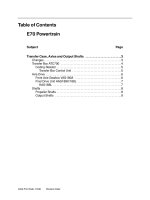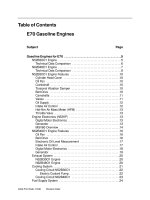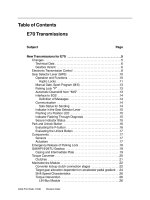C1311 02
Bạn đang xem bản rút gọn của tài liệu. Xem và tải ngay bản đầy đủ của tài liệu tại đây (13.07 KB, 2 trang )
Designation: C 1311 – 02
Standard Specification for
Solvent Release Sealants1
This standard is issued under the fixed designation C 1311; the number immediately following the designation indicates the year of
original adoption or, in the case of revision, the year of last revision. A number in parentheses indicates the year of last reapproval. A
superscript epsilon (e) indicates an editorial change since the last revision or reapproval.
1. Scope
1.1 This specification describes the properties of a onecomponent solvent release sealant for use in building construction. These sealants are generally formulated to withstand a
maximum joint movement of 7.5 % in extension and 7.5 % in
compression of the nominal joint width.
1.2 The values stated in SI units are to be regarded as the
standard. The values given in parentheses are for information
only.
1.3 The committee with jurisdiction of this specification is
not aware of any similar specification within ISO or any other
organization.
4. Materials and Manufacture
4.1 The sealing compound shall be a solvent release material compounded to conform to the requirements prescribed in
this specification.
4.2 All material and workmanship shall be in accordance
with good commercial practice. The producer is permitted a
wide latitude in choice of raw materials for making these
products. Consequently, there is no implication that the compounds are equivalent in all physical properties.
4.3 The manufacturing process shall be such as will ensure
a homogeneous mix, free of defects that would affect serviceability, and of a consistency suitable for immediate application.
2. Referenced Documents
2.1 ASTM Standards:
C 661 Test Method for Indentation Hardness of
Elastomeric-Type Sealants by Means of a Durometer2
C 712 Test Method for Bubbling of One-Part, Elastomeric,
Solvent-Release Type Sealants2
C 717 Terminology of Building Seals and Sealants2
C 1193 Guide for Use of Joint Sealants2
C 1216 Test Method for Adhesion and Cohesion of OnePart Elastomeric Solvent Release Sealants2
C 1257 Test Method for Accelerated Weathering of SolventRelease-Type Sealants2
D 2202 Test Method for Slump of Sealants2
D 2203 Test Method for Staining from Sealants2
D 2377 Test Method for Tack-Free Time of Caulking Compounds and Sealants2
D 2452 Test Method for Extrudability of Oil- and ResinBase Caulking Compounds2
5. General Requirements
5.1 Standard Conditions—Perform all of the tests in a
laboratory controlled at 23 6 2°C (73 6 3.6°F) and 50 6 10 %
relative humidity. Condition sealant samples for at least 5 h at
these conditions before any tests are performed.
5.2 The sealant in the original container shall be suitable for
use for at least 12 months from the date of manufacture when
stored at a temperature neither below 5°C (41.0°F) nor
exceeding 27°C (80.6°F).
5.3 The color of the sealant shall be as agreed upon between
the purchaser and the manufacturer.
5.4 The sealant shall be intended for use only on clean, dry
surfaces. When a primer is recommended by a manufacturer
for a specific substrate, all tests on that substrate shall include
the primer. The proper use of primers (or surface conditioners)
with the application of sealants is described in detail in Guide
C 1193. This guide also describes proper methods for joint
design, backup materials, surface preparation, tooling of sealant, and other important procedures in sealant application in
buildings.
3. Terminology
3.1 Definitions—Definitions of the following terms used in
this specification are found in Terminology C 717: adhesive
failure (adhesion loss), caulk (v), compound, durometer, hardness, joint, primer, seal, sealant, sealing material, and solvent
release sealant.
6. Significance and Use
6.1 This specification describes solvent release sealants for
general caulking and sealing operations in building construction. However, it should be recognized by the user that not all
sealants meeting this specification are suitable for all applications and all substrates and that there is no implication that the
sealants are equivalent in all physical properties.
6.2 Refer to Guide C 1193 for information on the proper use
of sealants meeting this specification.
1
This specification is under the jurisdiction of ASTM Committee C24 on
Building Seals and Sealants and is under the direct responsibility of Subcommittee
C24.20 on General Sealant Standards.
Current edition approved May 10, 2002. Published June 2002. Originally
published as C 1311–95. Last previous edition C 1311–95.
2
Annual Book of ASTM Standards, Vol 04.07.
Copyright © ASTM International, 100 Barr Harbor Drive, PO Box C700, West Conshohocken, PA 19428-2959, United States.
1
C 1311 – 02
7. Physical Requirements
7.1 The sealant shall conform to the physical requirements
specified in Table 1.
8.4 Accelerated Weathering—Refer to Test Method C 1257.
8.5 Slump—Refer to Test Method D 2202.
8.6 Staining—Refer to Test Method D 2203.
8.7 Tack-Free Time—Refer to Test Method D 2377.
8.8 Extrudability After Aging—Refer to Test Method
D 2452.
8. Test Methods
8.1 Indentation Hardness—Refer to Test Method C 661.
8.2 Bubbling—Refer to Test Method C 712.
8.3 Adhesion and Cohesion After Cyclic Movement—Refer
to Test Method C 1216.
9. Packaging and Package Marking
9.1 Unless otherwise specified in the contract or order, the
sealant shall be packaged in standard commercial containers
constructed so as to ensure acceptance by common or other
carrier for safe transportation to the point of delivery.
9.2 Shipping containers shall be marked with the name,
grade, and quantity of the sealant contained therein, as defined
by the contract or order under which shipments are made. The
name of the supplier and the lot or batch shall also be shown.
TABLE 1 Physical Requirements
Property
Extrudability
Shore A hardness
Bubbling
Adhesive and cohesive loss
Slump
Stain index
Tack-free time
Accelerated weathering
Edge cracking
Center cracking
Adhesion loss
Color Change
Requirement
9/s/mL, max
50, max
25 %, max
9 cm2(1.5 in.2), max per
substrate
0.38 cm (0.15 in.), max
3, max
72 h, max
Test Method
D 2452
C 661
C 712
C 1216
D 2202
D 2203
D 2377
C 1257
10. Keywords
3, max
3, max
3, max
as agreed
10.1 accelerated weathering; application life; bubbling; extrusion rate; sealant; sealing compound (sealing material);
slump; solvent-release sealant; staining; tack free
ASTM International takes no position respecting the validity of any patent rights asserted in connection with any item mentioned
in this standard. Users of this standard are expressly advised that determination of the validity of any such patent rights, and the risk
of infringement of such rights, are entirely their own responsibility.
This standard is subject to revision at any time by the responsible technical committee and must be reviewed every five years and
if not revised, either reapproved or withdrawn. Your comments are invited either for revision of this standard or for additional standards
and should be addressed to ASTM International Headquarters. Your comments will receive careful consideration at a meeting of the
responsible technical committee, which you may attend. If you feel that your comments have not received a fair hearing you should
make your views known to the ASTM Committee on Standards, at the address shown below.
This standard is copyrighted by ASTM International, 100 Barr Harbor Drive, PO Box C700, West Conshohocken, PA 19428-2959,
United States. Individual reprints (single or multiple copies) of this standard may be obtained by contacting ASTM at the above
address or at 610-832-9585 (phone), 610-832-9555 (fax), or (e-mail); or through the ASTM website
(www.astm.org).
2









